
When the wireless industry embarked on the creation of 5G, 2020 seemed so far away. Now we are quickly closing in on 2020 and this will most certainly be the 5G decade. Every day there are announcements in the press of new field trials and upcoming commercial 5G rollouts.
It’s a very exciting time for the wireless industry. Currently, much of the industry 5G focus is on enhanced mobile broadband, driving toward higher and higher network capacity and throughput utilising beamforming techniques in the mid-band and high-band spectrum. We are also beginning to see use cases emerge, such as industrial automation, that leverage the low latency features of the 5G network architecture.
It was only a few years ago that the industry was debating the feasibility of using the millimetre-wave spectrum for mobile communications and framing the challenges that lay ahead for the radio designer. Much has transpired in a short time and the industry has progressed rapidly from initial prototypes to successful field trials and now we are on the verge of the first commercial 5G millimetre-wave deployments.
Many of the initial deployments will be for fixed or nomadic wireless applications, but we will also see truly mobile connectivity at millimetre-wave frequencies in the not so distant future. The first standards are in place, technology is quickly evolving, and much learning has transpired around the deployment of millimetre-wave systems. While we have made much progress, there remain many challenges ahead for the radio designer. Let’s examine some of these challenges for the RF designer in the remainder of this article.
Deployment scenarios and propagation considerations
When we are developing technology, it’s critical to understand how the technology will ultimately be deployed. In all engineering exercises, there are trade-offs to be made, and with additional insight creative innovations may emerge. In Figure 1, we highlight two of the common scenarios being explored today in the 28 GHz and 39 GHz spectrum.
Figure 1a illustrates a fixed wireless access (FWA) use case, where we are trying to deliver high-bandwidth data to homes in a suburban environment. In such a case, the base station will be on a utility pole or tower and is required to cover a large area to produce a positive business case.
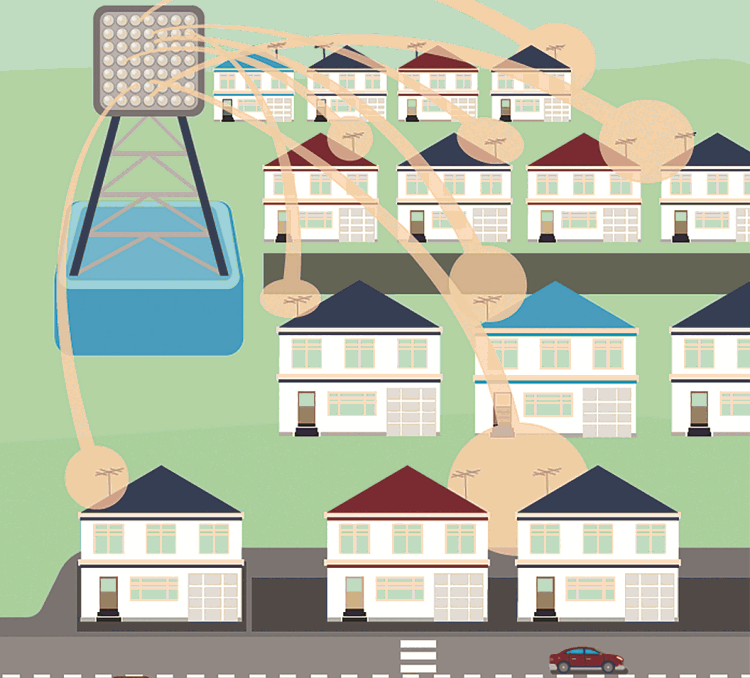
In the initial deployments, we assume that the coverage is outdoor to outdoor, whereby the customer premises equipment (CPE) is mounted outdoors and the link may be engineered to ensure the best over-the-air connection. Given that the antenna is pointing down and users are fixed, we may not require a large amount of vertical steering range, but the transmitted power may be quite high, in excess of 65 dBm EIRP to maximise the coverage and leverage existing infrastructure.
In Figure 1b we illustrate a dense urban scenario, where the base station will be mounted lower to the ground on a building rooftop or façade, possibly evolving to streetlight or other street-level mounting in the future. In any case, this type of base station will require vertical scanning ability to deliver signals across the entire building elevation and eventually to mobile or nomadic users on the ground (pedestrians and vehicles) as mobile devices emerge.

In this case the transmitted power may not need to be so high as in the suburban case, although low-E (low-emissivity) glass has proven to be a problem for outdoor to indoor penetration. As shown, we will need more flexibility in the beam scanning range, in both the horizontal and vertical axes. The major takeaway here is that there is not a one-size-fits-all solution. The deployment scenario will determine beamforming architecture and the architecture will influence the choice of RF technology.
Millimetre-wave beamforming
Now let’s consider the various approaches to beamforming: analog, digital, and hybrid, as shown in Figure 2. I’m sure we are all familiar with the concept of analog beamforming as this topic has been quite popular in the literature in recent years. Here we have data converters translating the digital signals to and from broadband baseband or IF signals, connecting a radio transceiver performing the up-conversion and down-conversion processes.
At RF (for example, 28 GHz), we split the single RF path into several paths where we perform the beamforming by controlling the phase of each path so that a beam is formed in the far field in the direction of the intended user. This enables a single beam to be steered per data path, so in theory we can serve one user at a time with this architecture.
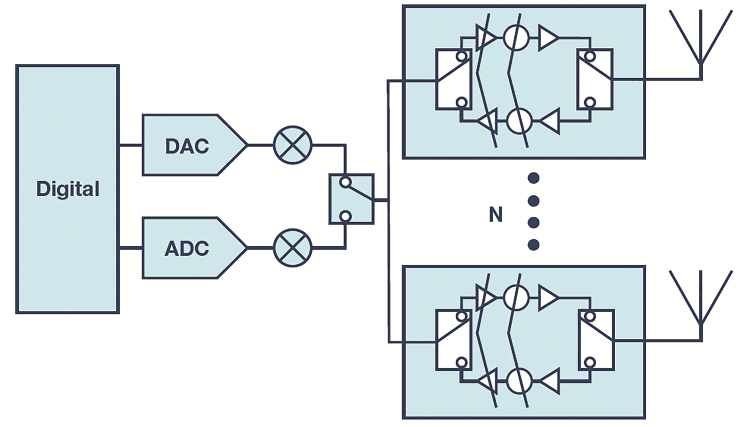
The digital beamformer is exactly what it sounds like. The phase shift is purely implemented in the digital circuitry and then fed to the antenna array through an array of transceivers. Simply speaking, each radio transceiver is connected to a single antenna element, but in practice there could be several antenna elements per radio depending on the desired sector shape.
The digital approach enables the highest capacity and flexibility and enables the roadmap to multi-user MIMO at millimetre-wave frequency, similar to mid band systems. It is highly complex and, given currently available technology, will consume an excessive amount of DC power both in RF and digital circuits. However, as technology evolves in the future, digital beamforming will emerge for millimetre-wave radios.
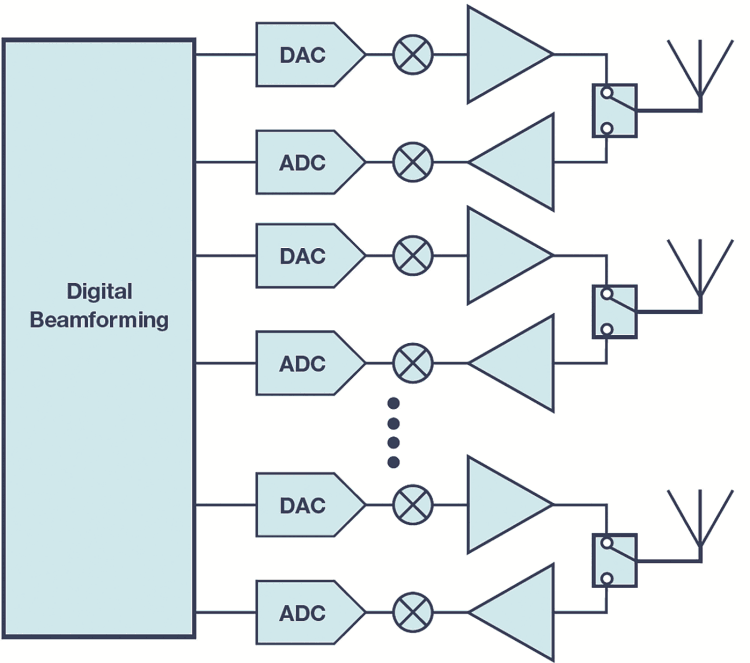
The most practical and effective beamforming approach in the near term is the hybrid digital-analog beamformer, which essentially combines digital precoding and analog beamforming to create several beams simultaneously in a space (spatial multiplexing). By directing power toward the intended users with narrow beams, the base station can reuse the same spectrum to simultaneously serve more than one user in a given timeslot.
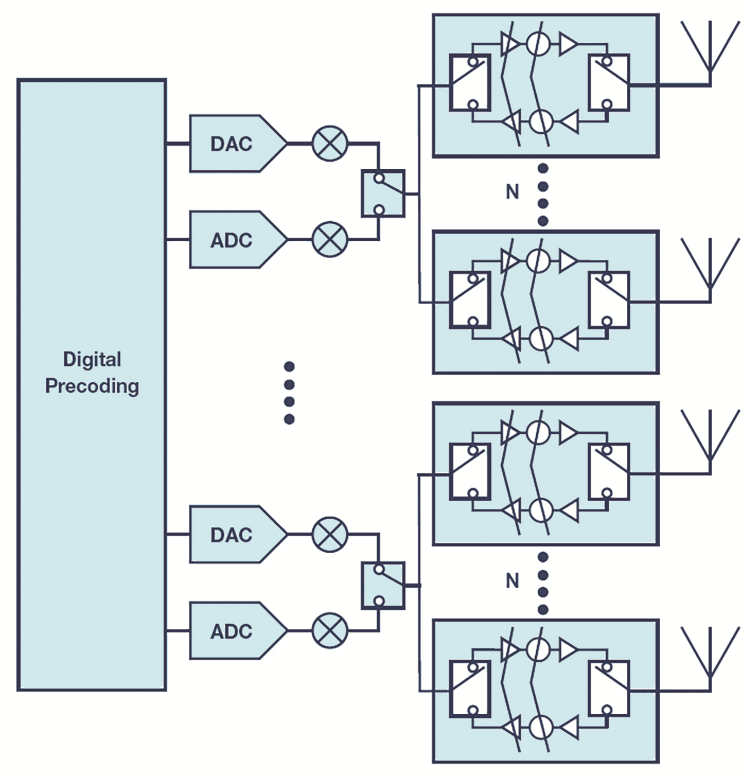
While there are a few different approaches to the hybrid beamformer reported in the literature, the subarray approach shown here is most practically implemented and is essentially a step and repeat of analog beamformers. Currently, reported systems support from 2 up to 8 digital streams in practice, which can be utilised to simultaneously support individual users, or alternatively provide 2 or more layers of MIMO to a lesser number of users.
Millimetre-wave radio: From bits to millimetre-wave and back
Let’s move on now to the bits-to-millimetre-wave radio in more detail and explore the challenges in this section of the system. It’s critical to translate the bits to millimetre-wave and back with high fidelity to support high order modulation techniques such as 64 QAM and possibly as high as 256 QAM in future systems.
One of the main challenges for these new radios is bandwidth. The 5G millimetre-wave radios must nominally process 1 GHz of bandwidth or possibly higher depending on how the spectrum is allocated in practice. While 1 GHz of bandwidth at 28 GHz is a low relative (3,5%) bandwidth, that same bandwidth at an IF of, say, 3 GHz is much more challenging to design for and requires some leading-edge technology to achieve a high-performance design.
Figure 3 illustrates an example of a block diagram for a high-performance bits-to-millimetre-wave radio based on components form Analog Devices’ broad RF and mixed-signal product portfolio. This signal chain has been demonstrated to support contiguous 8 - 100 MHz NR carriers at 28 GHz with exceptional error vector magnitude (EVM) performance. More details on this signal chain and its demonstrated performance can be found in the Analog Devices video, ‘5G Millimetre-wave Base Station’ (www.dataweek.co.za/*ADI-5G-vid, redirects to www.analog.com/en/education/education-library/videos/5804450511001.html#).
Let’s consider data converters. In the example in Figure 3, we show direct high-IF transmitter launch and high-IF receiver sampling used, where the data converters are launching and receiving at the intermediate frequency. The IF needs to be as high as can be reasonably achieved to avoid unwieldly image filtering at RF, driving the IF frequency to 3 GHz and above. Fortunately, leading-edge data converters are capable of operating at this frequency.
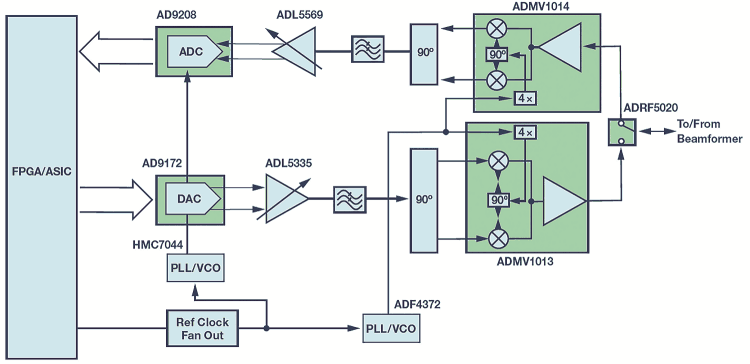
The AD9172 is a high performance, dual, 16-bit DAC that supports sample rates up to 12,6 GSps. The device features an 8-lane, 15 Gbps JESD204B data input port, a high-performance, on-chip DAC clock multiplier, and digital signal processing capabilities supporting broadband and multiband direct-to-RF signal generation up to 6 GHz.
In the receiver we show the AD9208, a dual, 14-bit, 3 GSps ADC. The device has an on-chip buffer and a sample-and-hold circuit designed for low power, small size, and ease of use. This product is designed to support communications applications capable of direct sampling wide bandwidth analog signals of up to 5 GHz.
In both the transmit and receive IF stages we suggest digital gain amplifiers that convert from single to balanced and vice versa to avoid the use of baluns. Here we show the ADL5335 in the transmit chain and the ADL5569 in the receive chain as examples of high performance broadband amplifiers.
For the up-conversion and down-conversion between IF and millimetre-wave, we have recently introduced both a silicon-based broadband up-converter, the ADMV1013, and a down-converter, the ADMV1014. These broadband frequency conversion devices operate from 24,5 GHz to 43,5 GHz. This broad frequency coverage allows the designer to address all of the currently defined 5G millimetre-wave spectrum bands (3GPP bands n257, n258, n260, and n261) with a single radio design. Both support an IF interface up to 6 GHz and two frequency conversion modes.
As shown in Figure 3, both devices include an on-chip 4x local oscillator (LO) multiplier with LO input ranging from 5,4 GHz to 11,75 GHz. The ADMV1013 supports both direct conversion from baseband I/Q to RF and single sideband up-conversion from IF. It provides 14 dB of conversion gain at a high output IP3 of 24 dBm. If implemented in a single sideband conversion, as illustrated in Figure 3 the device provides 25 dB of sideband suppression.
The ADMV1014 supports both direct conversion from RF to baseband I/Q and image reject down-conversion to IF. It provides a conversion gain of
20 dB with a noise figure of 3,5 dB and an input IP3 of -4 dBm. The sideband suppression in image reject mode is 28 dB.
The final component in the RF chain is the ADRF5020 broadband silicon SPDT switch. The ADRF5020 provides both a low insertion loss of
2 dB and high isolation of 60 dB at 30 GHz.
Finally, let’s discuss the frequency sources. Given that the local oscillator may be a large contributor to the EVM budget, it’s important to use a source with very low phase noise for the millimetre-wave LO generation.
The ADF4372 is a wideband microwave synthesiser with an industry-leading integrated PLL and ultralow phase noise VCO with output capable of 62,5 MHz to 16 GHz. It allows for the implementation of fractional-N or integer-N phase-locked loop (PLL) frequency synthesisers when used with an external loop filter and an external reference frequency. VCO phase noise at 8 GHz is an impressive -111 dBc/Hz for 100 kHz offset and
-134 dBc/Hz at 1 MHz offset.
The block diagram in Figure 3 is a good starting point for any designer considering a millimetre-wave design in the 28 GHz and 39 GHz bands and suitable for use with a variety of beamforming front ends requiring a high-performance broadband radio. There are also many components listed in Analog Devices’ RF, microwave, and millimetre-wave products selection guide that may be of interest to the designer for other signal chain architectures or for similar high-frequency applications.
Summary
Millimetre-wave radios have seen great progress in recent years, moving out of the lab to field trials with commercial deployments that are launching in the coming months. The evolving ecosystem and emerging use cases require some flexibility in the beamforming front end, but as discussed there are suitable technologies and approaches to choose from for the near antenna designs.
The broadband nature of the radio (bits to millimetre-wave) demands leading-edge technology, but silicon-based technology is quickly evolving to meet the requirements in the mixed-signal and small-signal domains. A high-performance radio design example has been presented based on currently available components.
As the 5G ecosystem continues to evolve, Analog Devices will continue to bring to bear its leading-edge technologies and signal chain solutions to enable its customers to develop differentiated systems for the emerging 5G millimetre-wave market.
| Tel: | +27 11 923 9600 |
| Email: | [email protected] |
| www: | www.altronarrow.com |
| Articles: | More information and articles about Altron Arrow |

© Technews Publishing (Pty) Ltd | All Rights Reserved